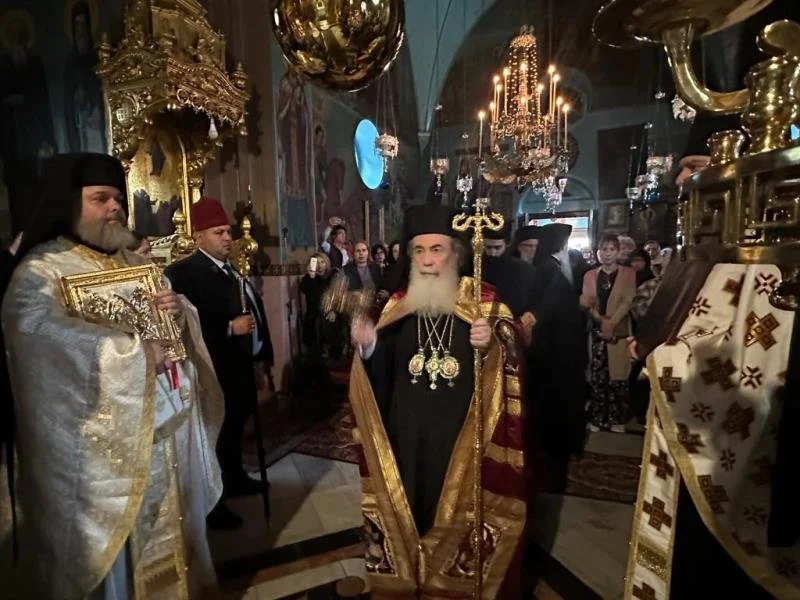The Feast of Lazarus Saturday at the Greek Orthodox Patriarchate of Jerusalem
On Saturday, March 26/April 8, 2023, the feast of the resurrection of Lazarus was celebrated by the Greek Orthodox Patriarchate of Jerusalem in Bethany and on the Mount of Olives. On this feast day, the whole Church, even that of Jerusalem, celebrates what was handed down in the Gospel of John (11:1-45) of the raising from the dead of the four-day-dead friend of the Lord Lazarus, in testimony of the common resurrection before His Passion: “Giving us before Thy passion an assurance of the general Resurrection, Thou hast raised Lazarus from the dead, O Christ our God”.
This feast was celebrated in the Holy Monastery of his sisters Martha and Mary with a Divine Liturgy presided over by His Beatitude Greek Orthodox Patriarch of Jerusalem, Theophilos III, with the co-celebration of their Eminences the Archbishops, Aristarchos of Constantina, Demetrios of Lydda and Philoumenos of Pella, the Elder Kamarasis Archimandrite Nectarios, the Steward of the Monastery Archimandrite Epiphanios, Fr Dometianos and Archdeacon Mark. The chanting was delivered by Mr Gotsopoulos, and Monk Joseph from Mount Athos, as the service was attended by the Consul General of Greece in Jerusalem Mr Vlioras and a multitude of believers.
His Beatitude Greek Orthodox Patriarch of Jerusalem, Theophilos III delivered the following Sermon before the Holy Communion:
“Before Thine own death, O Christ, Thou hast raised from hell Lazarus that was four days dead, and hast taken the dominion of death. Through this one man whom Thou hast loved, Thou hast foretold the deliverance of all men from corruption. We, therefore, worship Thine almighty power and cry: Blessed art Thou, O Saviour, have mercy upon us” (Lazarus Saturday Matins, praises, Troparion 2).
Beloved Brethren in Christ,
Reverend Christians and pilgrims
The grace of the holy and righteous Lazarus has gathered us all in this holy place of his hometown Bethany, to celebrate his resurrection from the dead and glorify our Lord Jesus Christ Who appeared to us and said to Lazarus’ sister Martha, “I am the resurrection, and the life: he that believeth in me, though he were dead, yet shall he live: And whosoever liveth and believeth in me shall never die” (John 11:25-26).
Approaching Jesus Christ’s entrance to Jerusalem with palm trees’ branches, where He suffered death on the Cross as well as His three-day burial and the luminous resurrection, the Lord visited Lazarus, whom He raised from the dead, “he cried with a loud voice, Lazarus, come forth. And he that was dead came forth, bound hand and foot with graveclothes: and his face was bound about with a napkin” (John 11:43-44), according to the testimony of Saint John the Evangelist.
Interpreting these words from the Gospel, Saint Cyril of Alexandria says: “Lazarus’ miracle is a type of the complete resurrection from the dead, and having accomplished this, He set forth a good image of what is going to happen in general”. And the hymnographer exclaims: “Giving us before Thy passion an assurance of the general resurrection, Thou hast raised Lazarus from the dead, O Christ our God” (Apolytikion).
Christ’s resurrection, my dear brethren, is not a mere miracle, incomprehensible to the human mind, but rather, and primarily, freedom from the death of corruption, namely of sin, as the hymnographer says very clearly: “Thou hast raised from hell Lazarus that was four days dead, and hast taken the dominion of death. Through this one man whom Thou hast loved, Thou hast foretold the deliverance of all men from corruption”.
This very message of the common resurrection, that is, the foretelling of the deliverance from the corruption of the death of sin for humankind, did Christ boldly denote before many people, as well as before His own disciples, through the resurrection of His friend Lazarus. In other words, Christ is the liberation of man, that is why Saint Paul advices: “Stand fast therefore in the liberty wherewith Christ hath made us free and be not entangled again with the yoke of bondage” (Gal. 5:1).
Death is the primary enemy of man, that is why Saint Paul preaches: “The last enemy that shall be destroyed is death” (1 Cor. 15:26). Interpreting these words of Paul, Saint Chrysostom says: “How is death the last [enemy]? It comes after all others, after the devil, after all other things. At first comes the devil’s council and the disobedience, and then, death”. And Zygavinos notes: “He called the death an enemy, as someone who fights against God’s creature, and an appellant and a minister of the devil”.
Christ, my dear ones, is the one who reconciled man with His death, so that He may present man as holy and immaculate and free from any condemnation. Saint Paul says, “Yet now hath he reconciled in the body of his flesh through death, to present you holy and unblameable and unreproveable in his sight” (Col. 1:21-22)…
This news was originally published on the website of the Greek Orthodox Patriarchate of Jerusalem. Please click here to read the full text.











